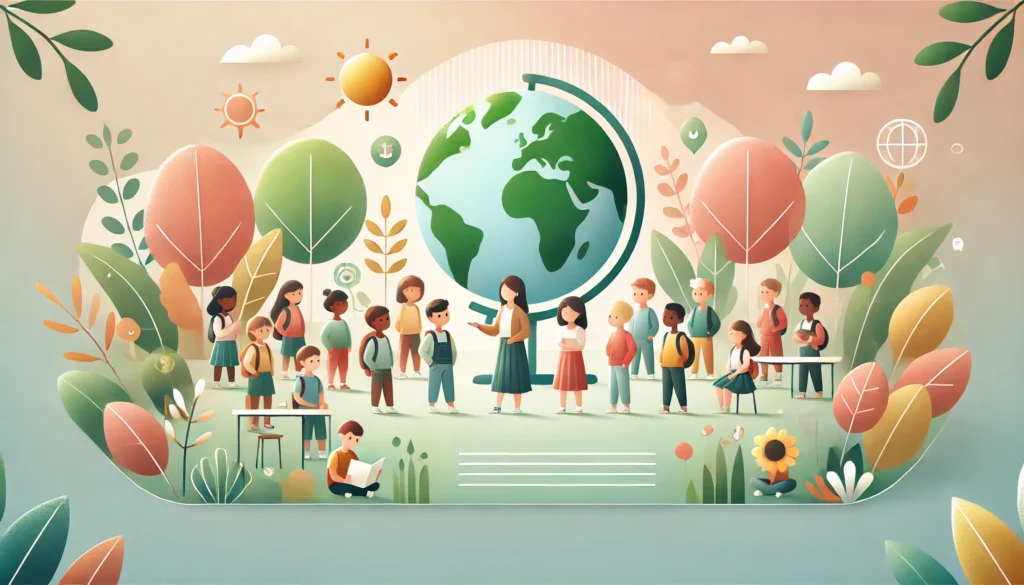I recently had a conversation with a neighbor that really made me think about how I present the idea of Climate Change to my classroom. It’s so easy to feel pressure to guide students toward a specific viewpoint, especially when the subject feels urgent or tied up in current events and political discourse.
The powerful realization I had was this: my job isn’t to sway them one way or the other. Instead, it’s to give them the critical thinking tools so they can come to their own conclusions. Conclusions that are based on a shared responsibility for what is best for our planet.
When we remove the fear (and the politics), we can shift the discussion from overwhelming doom to empowering, hands-on problem-solving. This guide offers a framework for keeping your classroom a place of positive action and inquiry.
The Core Principle: Instructional Neutrality
Your role as an educator is not to convince students of an opinion, but to equip them with the facts and tools to make their own informed decisions. Teaching climate science requires that you maintain strict neutrality, focusing on evidence, not advocacy.
- Focus on the Science: Make sure to really understand your State Science Standards and what is acceptable to be discussed in your school. Having a grasp on these foundational principles is key to bringing relevant data to the table.
- Teach Choices, Not Conclusions: Frame the discussion as a series of societal choices with different consequences. Instead of telling students the “right answer,” ask: “What are the costs and benefits of using the sun for energy versus burning coal?” This promotes analysis over obedience.
- Empowerment Over Persuasion: When you provide students with data, empower them to evaluate solutions and think critically. This shifts the classroom from a political platform to an innovation lab.
Implementation Ideas: Five Non-Political Classroom Projects
These activities integrate sustainability into existing lessons, focusing on data, engineering, and economics.
1. The Future Jobs Market (Career Readiness)
Introduce climate solutions as a huge driver of economic opportunity and future careers.
- The Data: Renewable energy jobs (like solar and wind) are one of the fastest-growing job sectors globally. This is not a distant future; it’s happening now. For example, the U.S. solar energy sector alone employed nearly 280,000 workers in 2023, a trend driven by the demand for installation and maintenance.
- Activity: “Future Green Jobs.” Have students research and illustrate roles in this expanding field.
- K-2: Introduce students to a “Wind Turbine Builder” or a “Solar Panel Roofer.”
- 3-5: Research the skills needed to be a “Battery Engineer,” a “Sustainable Architect,” or a “Resilient Crop Scientist.” This frames the issue as an exciting, solvable challenge that awaits their generation.
2. Soil Quality: The Earth’s Carbon Sponge
Soil is a critical resource for food and climate health.
- The Data: Healthy forest soil stores vast amounts of carbon. When trees are cut down (deforestation), the soil washes away (erosion), releasing stored carbon and leaving the land unusable. It takes hundreds of years to create an inch of healthy topsoil.
- Activity: Soil Erosion Experiment. Put soil in two containers. In one, plant grass; leave the other bare. Pour the same amount of water over both. Students will observe that the container with plants has cleaner runoff and loses less soil, demonstrating how roots anchor the soil.
3. The Energy Audit Challenge (Math & Civic Action)
Turn energy conservation into a measurable, competitive team activity.
- The Data: Saving electricity at school saves money and reduces the amount of emissions that go into the Earth’s atmosphere.
- Activity: The “Power Patrol.” Appoint students as “Power Patrollers” to track simple things:
- Are the lights off when the class leaves the room?
- Is the computer screen dark?
- What was our water consumption for the day?
- Use a simple bar graph to track how many times the class successfully saves energy each day, turning conservation into a quantifiable metric.
4. Reduce, Reuse, & Repurpose Engineering (Art & Design)
Connect waste reduction to energy conservation and innovation.
- The Data: Reusing materials saves the energy required to make new products and keeps items out of landfills.
- Activity: Trash-to-Treasure Engineering. Challenge student groups to build a functional item (a pencil holder, a small storage container, or a model) using only clean recyclables (cardboard, plastic bottles, newspaper). This activity reinforces the concept that materials retain value and can be repurposed creatively.
5. Microclimate Investigation (Observation & Measurement)
Show students how human choices impact the temperature of their immediate surroundings.
- The Data: Dark, paved surfaces (like asphalt) absorb more heat than light-colored or green surfaces (like grass and trees). This contributes to the Urban Heat Island Effect.
- Activity: The Hot/Cool Walk. On a sunny day, use a thermometer (or just your hands) to measure the temperature of different surfaces: the grass, a patch of bare dirt, and the blacktop. Students record the data and graph the results. This provides immediate, physical evidence that adding green space (planting trees, using gardens) is a concrete solution to keeping their community cooler.
Prioritize The Planet
By shifting the focus from political division to practicality, you equip your students to prioritize the planet in every decision. Teaching climate science isn’t about choosing a side; it’s about instilling a sense of planetary stewardship, so that when they turn off a light, choose to recycle, or design future technology, they are always asking the most important question: “What is best for the Earth?”
Interested in Learning More About Sustainable STEM?
Take a look at some of the other blogs based on Sustainability in the Classroom.
